More green power for the Rivercafe
Today it gets a bit more technical: it dragged on like chewing gum and took a few weeks longer than planned – the environmentally friendly upgrade of the Rivercafe’s power supply. But now we are ready to sail again. As you read this, we have set sail again and are (hopefully) enjoying a relaxed energy supply.
After half a year on board, we wanted to become more independent of our diesel generator and produce more environmentally friendly solar power. Our carbon footprint is already big enough, a little smaller would be a good idea. And we want to become more independent. Hence the cover picture: Stéphane (our marvellous electrician), Ka and I pull the shore power cable for the last (hopefully) time.
Unlike in a house, electricity consumption is an important issue on a ship. In fact, I was never interested in Luxembourg. Do you know how many watts your coffee machine or washing machine need? Who cares. On a ship it’s different. You have to know exactly what you use with which appliances or installations. And of course how much electricity is available or can be provided.
As a passionate non-handyman, I didn’t have the slightest clue about all the electrical stuff. There’s quite a lot to learn about amps, watts and volts. Alexander Worms‘ book helped me to close my remarkably large knowledge gaps. Sorry, its a german book.
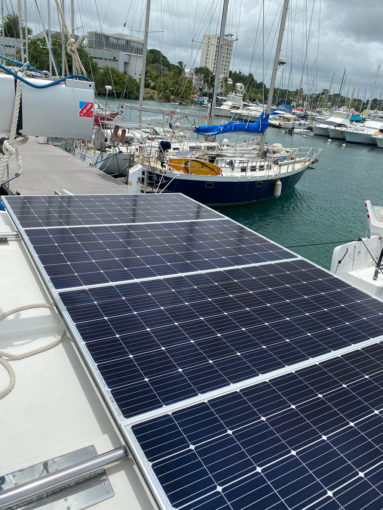
The power hogs
Our biggest power consumers on board are the watermaker – our water desalination system, the washing machine and the dive compressor that fills our tanks with air. Hot water, dishwasher and coffee machine quickly swallow up 1,400 watts and draw plenty of amps from the lithium batteries. For these three appliances, our existing 800-watt solar panels are sufficient for power supply. For the former power guzzlers, however, the diesel generator always had to supply the power. Exchange diesel for water or clean laundry.
Our “watermaker” is the most important consumer. It sucks in seawater, filters and desalinates it, and when the measured salt content is low enough, the fresh drinking water is filled into our fresh water tanks. This water tastes delicious and has a lower salt content than bottled water. Unfortunately, fresh water production is quite energy-intensive. To fill one tank – we have two tanks – the watermaker runs for just over 3 hours, producing just over 100 litres per hour. Every minute of that, until now, the generator had to run.
We have now changed that. With a catamaran, we have the fortunate advantage over a monohull in that we have more space to put solar panels. But the roof space is also limited, so we had a beam built and attached to the stern. The carrier holds the additional 8m2 of solar panels. We also increased our lithium batteries from 800 amps to 1,000 amps. And finally, we added another inverter. The whole installation needs a reliable control system so that only what fits into the batteries is fed in. Battery happy, life happy.
The plan is that with the new setup we won’t need a generator any more. We will only keep it for redundancy. In the future, we shouldn’t need shore power when we’re in marinas either. During the tests, everything looked good and ran smoothly.
Financially pointless – economically valuable
Economically, better said financial wise, the conversion is not really a good deal. Our generator could have run for more than 5,000 operating hours before breaking even on the cost of the upgrade. For us, the environmental friendliness and autonomy aspects are the convincing reasons. We will burn several thousand litres of diesel less.
Completing the entire installation, however, was much more involved than we imagined. Metal workers and electricians turned the Rivercafe into a construction site for days. And then a tool slipped and one of the four panels was damaged. We need a new one. It’s probably not surprising that there is no replacement in Guadeloupe. It has to be delivered from Europe. We will take care of that in Grenada. At least Stéphane was able to install and programme the electronics to a complete system.
The next few days of sailing will be a test to see if everything works as it should. Keep your fingers crossed that we can finally, finally, finally sail further south. /Holger Binz

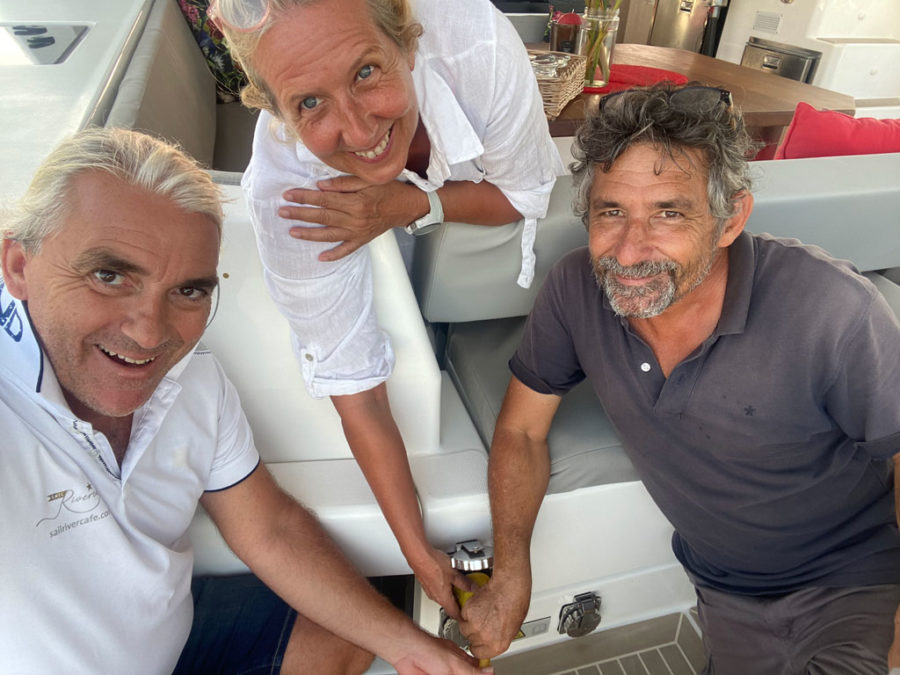
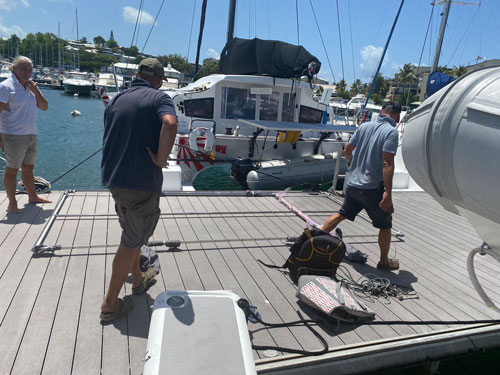
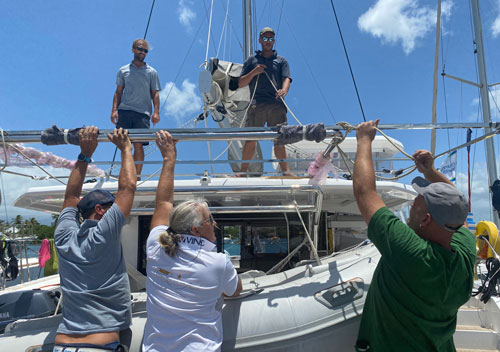


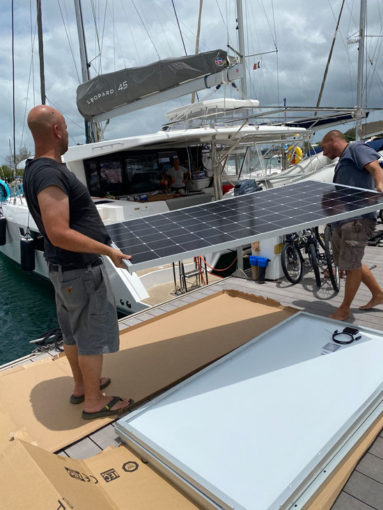


Hört sich gut an. Aber behaltet mal als Reserve die Generator-Lösung. Denn wenn die Sonne nicht scheint, gibt es wenig oder gar kein Strom aus den Solarpanels. Das schwankt bei unserer Hausanlage stark. Bei unserem Womo ist die kleine Anlage auch viel wert, denn man ist ja meist unterwegs wenn das Wetter gut ist.
Alles Gute
Jürgen
Bonjour mes amis,
Sehr interessanter Artikel obwohl ich nicht so begeistert bin von Technik … Aber ihr habt schon recht who cares here was wir an Strom brauchen (man muss ja nur den Schalter on und off machen)
Also news von Luxembourg ..es ist 9 Uhr, ich kucke das Fenster vom Büro raus und der Himmel ist blau und es ist Sonne da, fast nicht zu glauben nach so viele Tage regen… Und jetzt kann ich nur sagen ENJOY …
Ich vermisse euch
Valérie
Danke für euren Blog zu eurem Rivercafe! Ich kann mir vorstellen, dass es ein großes Unterfangen war, da Metallbauer und Elektriker wie ihr beschrieben habt, einige Tage damit beschäftigt waren. Dafür hat es sich umso mehr gelohnt!